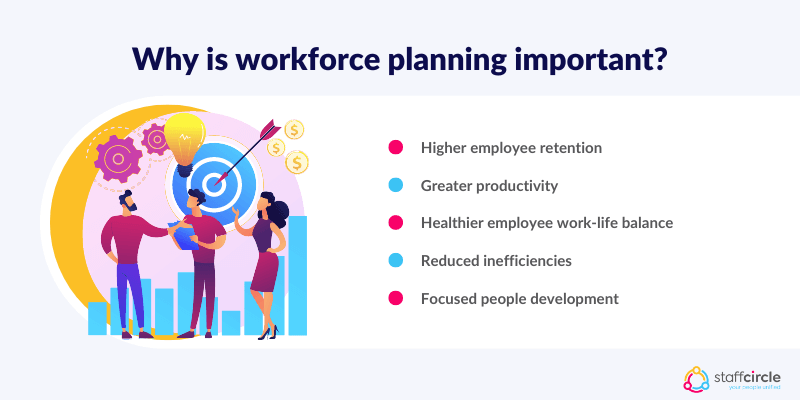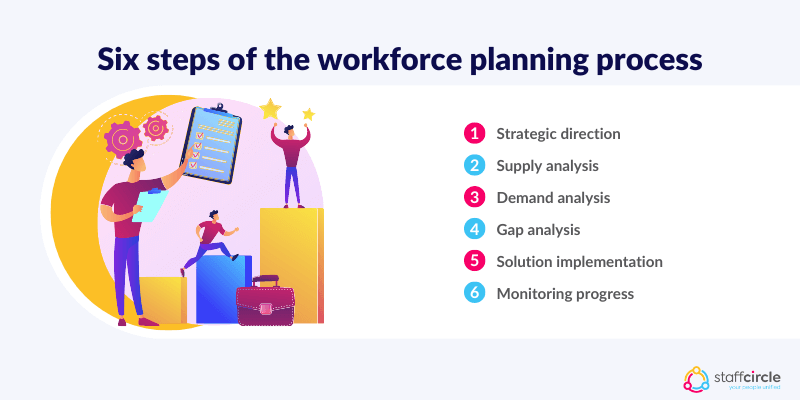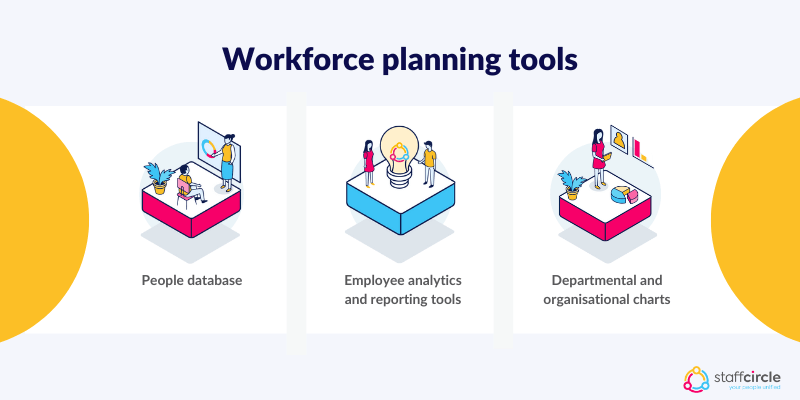Workforce planning, sometimes referred to as strategic workforce planning, is the process through which the workforce supply is analysed and forecasted to make sure the company can fulfil its staffing requirements. But what is a workforce plan?
By understanding the composition of the current workforce, business leaders and HR professionals are well-positioned to adapt their business strategy so that the best people are hired to achieve their goals.
This article will explore the importance of operational workforce planning, the core principles involved, and the workforce planning process required to create optimal hiring strategies.
Principles of Workforce planning
For operational workforce planning to be successful, some core principles need to be adhered to. One foundational principle is the involvement of all key stakeholders in the process, including those who are best positioned to determine the relevant skills needed for the organisation to fulfil its objectives.
This requires building the necessary educational capabilities to bring employees up to speed so they can complete their responsibilities to the highest possible standard. In order to do this, workforce planning needs to be constructed around a clear understanding of the specific demands of the company’s industry, based on firm data.

A report from the Harvard Business Review outlined the need for companies to align their workforce supply with business demand based on an understanding of how industry forces affect the company. The report states:
“They use data to assess the gap between the capabilities the company has and those it needs both immediately and in the future. Factors that might impact this gap include attrition, prevailing salary levels, location of the workforce versus business operations, and demographics, especially the age, education, and skills of the current and potential workforce.”
This data should be gathered as part of an ongoing process to match the ever-changing landscape of a given industry. By archiving this data as part of the human resources employee analytics and reports, it can be easily accessed whenever a drive for new hires is implemented.
What is the Importance of Workforce Planning?
Effective workforce planning brings a broad range of advantages to companies that adopt this as a core planning strategy.

Indeed, the importance of workforce planning cannot be understated, resulting in a variety of benefits that include:
- Higher employee retention. Turnover can cost companies large sums of money, with estimates pointing to a cost of $4,000 just to replace an employee who is paid $8 per hour. Effective workforce planning is geared towards retaining those employees with the most potential by creating clear career paths they can focus on accomplishing.
- Greater productivity. A comprehensive strategic workforce planning program helps HR and managers spot problems that decrease productivity, as well as highlight patterns they can replicate that get better results.
- A healthier work-life balance for employees. Understanding the necessity for rest and relaxation in the workforce is central to workforce planning. High-performing employees will lose their edge without a sufficient work-life balance, and workforce planning can help them to better manage their time and maximise well-being.
- A reduction in inefficiencies. A core aspect of the workforce planning process is identifying inefficiencies that are impeding performance. By reducing these inefficiencies – or eliminating them altogether – HR leaders can further optimise the roles and responsibilities of their employees.
- Focused people development. An employee’s professional development is most effective when it is directly tied to desired business outcomes. Training and development that adapts as the company’s strategic vision changes over time ensure this alignment remains even when disruptions occur.
Deloitte’s report on workforce planning solutions sums up how this process gives business leaders the necessary insights to make sure the right people are placed in the right roles.
“Critical to strategic workforce planning is an inventory of an organization’s skills and labor assets. Organizations with highly-skilled employees require a detailed accounting of qualifications, certifications, and general experiences to properly meet current and future workforce needs.”
As we’ll examine later, performance management tools provide the structure for HR leaders to build a consistent database of skills and assets to help deliver optimal strategic workforce planning.
Key Elements of a Strategic Workforce Plan
To be a sound workforce management plan, the design needs to be three-fold:
- Having clear objectives drawn from data-driven insights
- Creating a layout for every job role with a list of relevant skills, competencies, and metrics.
- Using the plan to streamline HR functions such as performance management, recruitment, retention, and succession planning.
With a strategic workforce management plan, you can maximise the potential of your organisation and get the most out of your workforce. Further, this allows you to take up supply analysis workforce planning, ensuring that you have a pipeline of workers for a given position in the organisation.
Additionally, the components of workforce planning need to make it flexible, scalable, address gaps and inefficiencies, reduce the overheads spent on labour, and increase retention. It should also pave the way to create training and development opportunities.
What are the Types of Workforce Planning?
Depending on their purpose, Workforce Planning can be classified as follows:
- Strategic Workforce Planning
A more tactical approach, strategic workforce planning involves finding the right talent and placing them in a position that offers the best ways to achieve the company’s goals. The basic approach lies in aligning the company’s human capital to business strategy.
This long-term approach makes an organisation resilient and adaptable to the business environment. Thus, it involves hiring the right workers, upskilling existing employees, and strategising to increase retention.
- Operational Workforce Planning
In response to immediate challenges that come up, HRMs need to take up operational workforce planning. Thus, this is geared towards routine tasks like staffing and scheduling, to ensure that no essential position is vacant.
By focusing on the present workforce, operational workforce planning keeps an organisation ready to respond to any staffing challenges and increases in demand/production.
Who is Responsible for Workforce Planning?
The workforce planning process is typically carried out by the HR department, which will be intimately involved in the data collection required for this to run smoothly. However, workforce planning requires the participation of other key players in order for it to be truly successful.
Senior corporate executives, business leaders, and other managers in various departments will all bring valuable input to the workforce planning process. This is essential for developing a holistic, long-term vision that understands a broad spectrum of desirable business strategy outcomes.
What is Workforce Planning and Why Is It Different From Workforce Management?
When we speak of workforce management, the main focus is on the organisation’s present workforce. Workforce planning or a workforce management plan takes on a much broader approach – it accounts for the needs of the future workforce and the organisation, alongside the present workforce.
Workforce planning is done to meet long-term goals, identify gaps in staffing, keep up with requirements, and ensure a pipeline of skilled workers for a job role. Thus, it accounts for the competencies of the workforce, evaluates the available talent pool, and gauges where they best fit in to achieve organisational objectives. As a result, it makes way for better talent acquisition, retention, and succession planning.
Workforce management targets daily and routine tasks such as attendance tracking, scheduling, target setting, appraisals, training, and compliance. Thus, it targets daily operational needs, placing people in positions that maximise operational efficiency and keep labour costs at a minimum. This enables organisations to automate and streamline processes and take up data-driven decision-making.
Though some aspects of both functions may overlap, they are fairly distinct.
Six Steps of the Workforce Planning Process
There are six fundamental steps involved in the workforce planning process. Let’s take a look at each of these steps in detail.
1. Strategic Direction
The first step for effective workforce planning requires a clear definition of the goals and objectives the organisation is working towards. Here, business leaders will set out where they see the company heading so that the requirements of the workforce are aligned with these outcomes.
2. Supply Analysis
Sometimes referred to as staffing analysis or workforce, supply analysis seeks to create an audit of the company’s existing workforce. This includes how many staff are currently employed, their roles and responsibilities, as well as the qualifications, credentials, and other experience relevant to the company’s overall mission.
3. Demand Analysis
Sometimes referred to as the demand model, a demand analysis is designed to play out what skills and roles will be needed over time to accomplish business objectives. Future organisational needs are assessed to help plan skills, costs, and other requirements.

4. Gap Analysis
This stage of the workforce planning process is designed to identify any gaps in the workforce that need to be closed in order to achieve success. This can cover a wide range of areas for consideration, from skill shortages and turnover rates to shortcomings in the recruitment process and how positions are designed to meet business goals.
5. Solution Implementation
Once the supply, demand, and gap analyses have been carefully carried out, it’s time to implement the proposed solutions. This should focus on workforce resourcing, training and development, and when necessary recruitment to make sure all employees are aligned to the core business strategy.
6. Monitoring Progress
Once a set of solutions have been implemented, it’s necessary to monitor how effective – or not – they are working out over time. This means progress should be monitored continually so that their impact can be assessed in real-time to ensure the solutions are having the desired effect.
Let’s take a look at the workforce planning tools you can use to both analyse and monitor progress when implementing a workforce plan.
What Makes Strategic Workforce Planning Successful?
At the very least, you can ensure the following benefits by opting for a workforce management plan:
- Closing Skill Gaps
Having a skill gap among workers is not out of the norm. With workforce planning, you can identify and manage any talent gaps in your organisation by opting for better recruitment strategies and L&D programs.
- Increasing Productivity of the Workforce
By placing the right staff in the right position as per their skill set and capabilities, you can maximise productivity of your operations.
- Cost Optimisation
With proper workforce planning, you place only the most suitable person in a given role, thus increasing productivity. Further, you can also streamline recruitment and reduce the time for which a position stays vacant. Together, these can potentially reduce overhead costs.
- Risk Mitigation and Workforce Resilience
Talent shortages can come up at any point due to market fluctuations, which can hamper production and service delivery. By opting for workforce planning, organisations already have contingency plans to respond to any issues that may come up. Thus, it allows businesses to adapt and maintain productivity and prevent disruptions.
- Ensuring an Agile, Adaptable Workforce
With rapid developments in the job market and industry, continuous reskilling and upskilling are essential. Proper workforce planning ensures that you have a system in place to keep the skillsets of your workers sharp.
- A Sound Long-term Recruitment Strategy
In every organisation, open positions continuously turn up either due to demand or employee turnover. Having a talent pipeline and recruitment strategy in place ensures that the position is filled quickly and with suitably skilled personnel.
- Managing Changes in the Workforce Demographic
As your senior employees retire, most of your new hires will be Gen-Z and younger millennials. Not only will you have to keep up with the expectations of this workforce, but also have to chalk out a way to bridge any skill gaps that occur.
Thus, the presence of the above acts as an indicator of the success of the deployed workforce management plan.
Workforce Planning Tools – Who Needs Them and How They Should Be Used
Workforce planning is a complicated process that requires ongoing monitoring in order to be successful. Fortunately, there is a range of tools that can be adopted to make sure this process runs as smoothly as possible.
Performance management software typically includes the necessary tools to accomplish organisational workforce planning. These tools can be accessed by business leaders and executives, as well as HR professionals so that data-driven decisions can be easily made.
Here are some of the tools you can use through performance management software to drive decisions around effective workforce planning:
People Database
Workforce planning begins with creating a clear overview of the current workforce, including any skills and qualifications they have that are necessary for the company’s success. HR operations can take advantage of a people database in performance management software to log all current employees in a central location, with accurate and up-to-date information about their role, team or department, and talent stack.

Employee Analytics and Reporting Tools
Whereas a people database gives HR professionals insights into the specific skills and abilities of individuals, employee analytics and reporting tools help them to assess their progress over time. By tracking core workforce metrics over time, they can spot trends and identify strengths and weaknesses that are essential for an effective workforce plan.
Departmental and Organisational Charts
People databases and analytics and reporting tools are essential for understanding performance at the individual level. When combined with departmental and organisational charts, business leaders can gain a birds’ eye view of how the company is functioning, and pinpoint the teams and departments that most need training and development.
Performance management software can automatically update these charts in real-time, reflecting current job titles and positions and allowing for efficient governance of the workflow. Workforce planning is often closely linked to the recruitment and onboarding process, so these charts can provide valuable insights into the corporate structure.
Plan Your Future With Data-driven Decisions
Workforce planning works best when it is based on data, and performance management software gives business leaders the necessary tools to gather and analyse data to drive the best decisions.
The article from Gallup, Successful Predictive Analytics Demand A Data-Driven Workplace, summarises the role high-quality data plays in effective strategies:
“Leaders need to ensure that their company’s analyses and processes are well-aligned, by using analytics activities to redefine decision structures, processes and rituals, rather than incorporating analytics into existing processes. A thoughtfully selected, well-integrated analysis provides decision-making support on crucial business problems and helps businesses improve their operational effectiveness.”
Summary
Workforce planning is essential for organisations to ensure operational continuity and meet the demands of an ever-changing industry.
By combining comprehensive data analytic tools with the six core stages of the workforce planning process, business leaders can work alongside HR professionals to ensure their employees are equipped to deliver strong performance and achieve the company’s core objectives.
Frequently Asked Questions
What is Workforce Planning?
When you align your staff management and recruitment strategies to organisational goals in response to any future needs that might come up, and manage your present workforce, the activity is called workforce planning.
Why is Workforce Planning Important?
The below factors make proper workforce planning and management important:
- Stay ahead of changes
- Ensure the scalability of the workforce
- Fill any existing skill gaps
- Improve workforce efficiency and reduce costs
- Increase employee engagement
How Does Workforce Planning Contribute to Business Success?
The primary benefits that workforce planning allows you to enjoy include:
- Improvement in productivity and deliverables.
- Strategic alignment of HR goals with business objectives.
- Lowering overhead costs.





